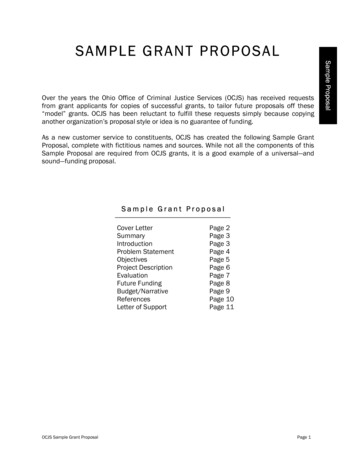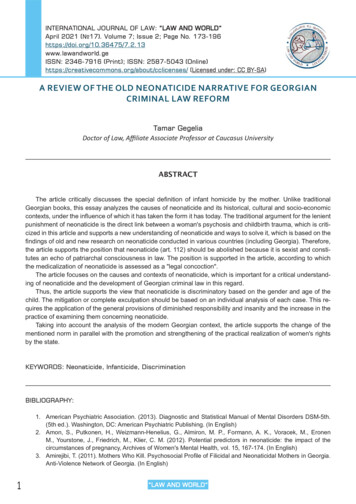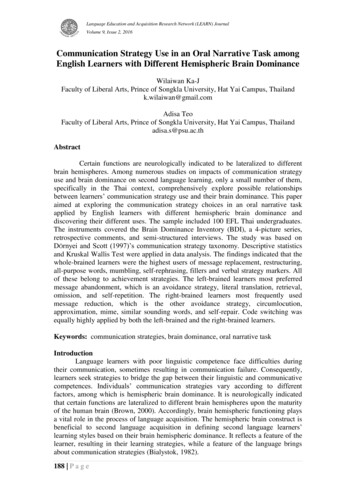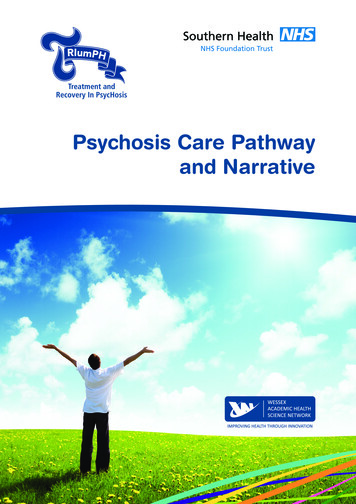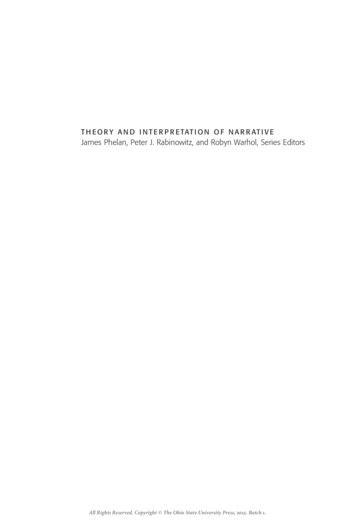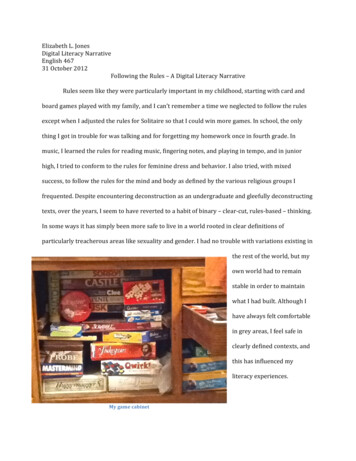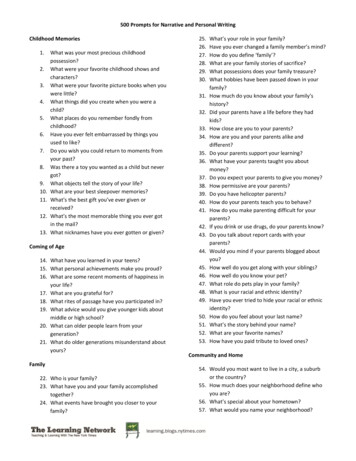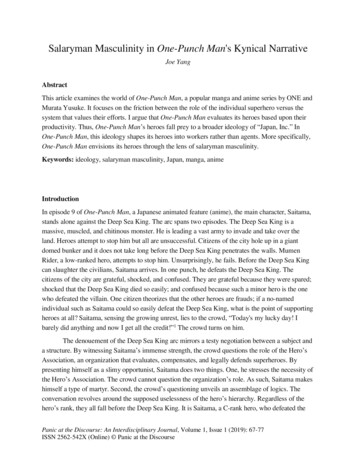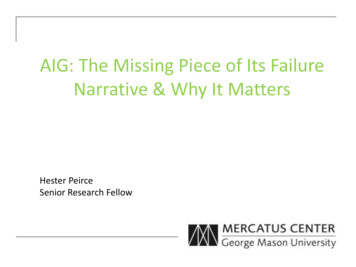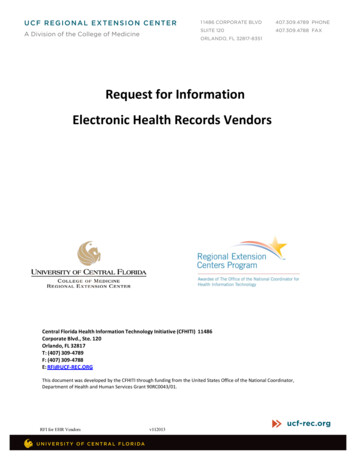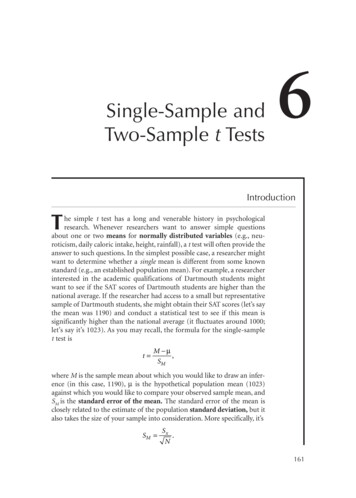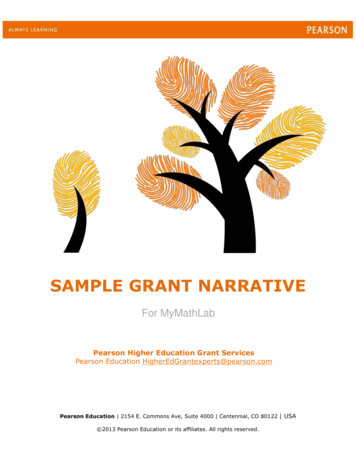
Transcription
SAMPLE GRANT NARRATIVEFor MyMathLabPearson Higher Education Grant ServicesPearson Education HigherEdGrantexperts@pearson.comPearson Education 2154 E. Commons Ave, Suite 4000 Centennial, CO 80122 USA 2013 Pearson Education or its affiliates. All rights reserved.
Sample Grant Narrative MyMathLab Page 2TABLE OF CONTENTSIntroduction . 3How to Use this Packet-FAQ . 4Stages of Grant Writing . 5Sample Proposal Narrative . 7Needs Assessment and Standards . 7Technology Need . 9Academic Need. 12Program Implementation . 15Professional Development . 22Leadership . 25Coordination of Activities . 28Program Evaluation. 29Works Cited . 35
Sample Grant Narrative MyMathLab Page 3INTRODUCTIONPearson (www.pearson.com) has been helping colleges, universities, and K-12 schools deliverinnovative education options since 1996 and are the world’s leading learning company, reachingmore than 130 million learners worldwide.Pearson works with more than 4,000 higher education institutions throughout NorthAmerica and many more learning organizations globally providing educational materials,technologies, assessments, and related services to instructors and students of all ages.Pearson is also a leading provider of electronic learning programs and of test development,processing, and scoring services to educational institutions, corporations, and professional bodiesaround the world. As a result of our expertise, the Pearson Higher Education Support ServicesGrants Team understands that the responsibility of writing grants for education funding is oftendifficult but also very necessary to accomplish, and because of that we have developed thissolution summary to help you in your efforts to write a compelling and high quality grantapplication.To assist you in responding to your grant opportunity, this document contains a compilation ofPearson learning tool solutions and summaries as they relate to the grant element provisions.Pearson’s Higher Education Support Services Grants Team can also provide a free reviewof your draft application featuring Pearson learning tool solutions and assess it againstgrant requirements. The document will be returned with embedded comments that indicateareas of strength and areas that should be revised.To receive this assistance, please contact your Pearson Account Executive or e-mail your draft toHigherEdGrantexperts@pearson.com.Please include the following information: Copy of the grant you are responding to. Name of Pearson Account Executive you are working with. Pearson solutions you are incorporating into your application. Draft application in Word (for review only).
Sample Grant Narrative MyMathLab Page 4HOW TO USE THIS PACKET-FAQsWhat’s a Help Packet?The Help Packet is a resource designed to assist you in the grant-writing process. It is intended tostand as a companion to the Request for Proposal. The Pearson solutions and summaries in thisdocument will provide you with ideas for how you might structure your response.How do I use the Help Packet?This Help Packet should be thought of as a model. The packet provides implementation ideas,especially for how Pearson Higher Education solutions meet grant requirements. However,because your institution’s needs and project vision are unique, you should customize thesummary solutions to reflect your specific plans. Use this document as you need: you maychoose to read the entire document, or if you are stuck on a certain section you may choose toturn there first.Can I cut and paste from the packet?You may cut and paste small sections as needed. However, your project has the best chance ofbeing funded if it is customized to your institution’s unique needs. Use the narrative as aresource, not as a final product. As you use the narrative, revise it to reflect your unique needs,project goals, and coordinating programs.For what stage in the grant-writing process is this packet intended?Effective grant writing and planning involves several stages. This Help Packet can be used as aresource during several stages, such as gathering information, writing the narrative, andcompleting the application.Should my finished application look like the Help Packet?Your finished application should reflect formatting requirements outlined in the grant. You shoulduse headings, bullets, and lists as appropriate to make the main ideas of your narrative clearlystated and easy to find. In particular, consider using the following: Embedded headings. Use embedded headings such as “Should my finished applicationlook like the Help Packet?” above—a bolded fragment, statement, or question identifying themain idea for that section. You don’t need one for each paragraph; just use them tocorrespond to the main sections of the narrative. Tables. Use tables, charts, or graphs for visual ease and summary.
Sample Grant Narrative MyMathLab Page 5STAGES OF GRANT WRITINGTo help you succeed and develop a thorough application, the stages below will guide you throughthe grant writing process. Pearson Higher Education can provide assistance throughout thesestages.Stage 1: Reading the grant application documents Download all available documents from the state, federal, or foundation Web site. Identify format requirements such as margin settings, font size, and line spacing. Identify the number of copies needed to be submitted. Note the authorized signature(s) needed before submitting your document. Note the dates and times for completing an online application. Note all priority requirements. Identify if multiple-year budgets are to be included. Review the scoring rubric for criteria to cover during the writing stage.Pearson Assistance: Look for callout boxes throughout the Help Packet. These give referenceto page numbers that identify pertinent information such as deadlines, formatting requirements,etc.Stage 2: Gathering information and researchGather the following types of information: Demographic data Test score data Research to support the project designPearson Assistance: Look for research citations embedded within the sample narrative. Refer tothe Works Cited page for pertinent research documents.Stage 3: Writing the project narrative Include all stakeholders in creating responses to each component of your project. Incorporate demographic and test score data, as well as research, to make your applicationconvincing and informative. Use the Help Packet sample narrative as a resource, not a final product. Use the Help Packet callout boxes for additional resources, tips for success, and grant pagenumber references to aid you in completing your application. Use headings, tables, and lists to clearly convey the project’s focus and to make priorityitems easy to find.
Sample Grant Narrative MyMathLab Page 6 Use the grant scoring rubric criteria in crafting component responses.Pearson Assistance: Use the Help Packet as a guide and model while crafting your response tothe grant.Stage 4: Completing budget narrative and required forms Develop the budget narrative based on project activities. Recheck budget totals for accuracy.Pearson Assistance: Contact your Pearson Higher Education Account Executive for budgetassistance.Stage 5: Reviewing your application Proofread the application for changes and revisions. Ensure that formatting requirements are consistent throughout the application narrative. Ask a qualified person to review the application (preferably someone who has not workedon the writing): give ample time to review the application and to identify areas that need to bestrengthened. Use the reviewer’s recommendation to revise the application narrative. Include all stakeholders in reviewing the final draft. Use the grant scoring rubric criteria to determine if your application meets all requirements.Pearson Assistance: The Pearson Higher Education Grants Support Services Team may beavailable to provide reviews for qualified applicants. Contact your Account Executive for moreinformation.Stage 6: Submitting your application on time Gather all authorized signatures and mail the application.OR Complete the online application and mail/fax authorized signature forms.Pearson Assistance: When you are notified of a grant award, contact your Pearson AccountExecutive to complete the ordering process.
Sample Grant Narrative MyMathLab Page 7SAMPLE PROPOSAL NARRATIVEThis sample narrative aligns with generic grant requirements. Be certain to customize yourresponse to your specific grant application.1. Needs Assessment and StandardsInstitution serves an at-risk population in multiple locations. Of these institution’s locations,have been identified as in need of improvement for math. Institution recognizes the need toreverse this achievement trend and has drafted this technology intervention plan in response.The Institution’s planning committee, consisting of the Provost,Vice President of Academic Affairs, technology director, curriculumWriting Tip. Develop a planningdirector, deans, faculty, board members, and parents, collaboratedcommittee to demonstrateon this project to ensure systemic commitment to the project andsystemic commitment to thealignment to district initiatives. Two of the initiatives in theproject and that the grantproject is well thought out.Institution include providing students with individualized instructionCustomize the description toto improve academic achievement and integrating technology intoreflect who is on yourthe curricula, assessment, and instruction. Institution’s project willcommittee.address those priorities and has support across all levels ofadministration, the leadership board, faculty, and other key stakeholders.The planning committee utilized data from the describe data source along with resources fordemographic data to select the locations to participate in this project. These locations wereselected because of their status as in need of improvement. In addition, the planning committeeconsidered the leadership and faculty of all locations for their commitment and capacity tochange. A thorough review of assessment scores, including disaggregated data, resulted in theplanning committee’s decision to provide intervention in mathematics instruction. Institution’slocation’s students’ assessment scores in math are disproportionately lower when compared tothe other locations’ students’ performance. Students from selected locations have historicallyscored well below standardized assessment averages on the name test with % students failingto achieve proficiency in math.
Sample Grant Narrative MyMathLab Page 8Table 1: Needs OverviewDemographic on2StateAvg.InstitutionAvg.Location1Location2Full or reduced TuitionStudents with DisabilitiesEnglish Language LearnersLevel of Achievement in Math% Freshman Students Below Proficiencyon the Year Math Test% of Sophomore Students BelowProficiency on the Year Math Test% of Junior Students Below Proficiencyon the Year Math TestCustomize Table 1 to reflect your student demographics and the number of locations to beserved. The table is a model of types of data that should be reported in your application.Statistical data should be used that further supports your need for grant funding to accomplishproject goals. Information on state and district demographics and achievement can be found atthese helpful sites: Graduation Rate by level nation&mode graph&state 0&submeasure 27 District Poverty Level: http://www.ed.gov/programs/lsl/eligibility.html District Statistics on ELL or SPED students: http://nces.ed.gov/globallocator/ School District Data: http://www.schoolmatters.com/To help these students achieve academic proficiency, Institution requires a proven, researchbased, authentic mathematics intervention. In particular, the planning committee identified thefollowing achievement gaps that need to be addressed: problem solving, estimating and verifyinganswers and solutions, logical reasoning, using technology, and include specific skills that needto be addressed among your students.The focus of the project, called Title, will be on Algebra,specifically Algebra 1 and Algebra 2. The goal is to increase ourTitle. Your project will stand out tostudents’ performance in math to prepare them for a successfulreviewers with a title. It will alsofuture. Research has found that “ math mastery and other criticalillustrate the level of dedication andeffort put into your planning.reasoning skills have become crucial to participate in theemerging economy,” (Carnegie Foundation for the Advancement of Teaching, Barbara Chow,2010). Students taking Algebra will have daily interaction with a digital curriculum t
This sample narrative aligns with generic grant requirements. Be certain to customize your response to your specific grant application. 1. Needs Assessment and Standards Institution serves an at-risk population in multiple locations. Of these institution’s locations, _ have been identified as in need of improvement for math. Institution recognizes the need to reverse this achievement trend .

